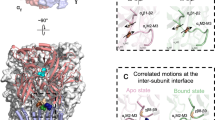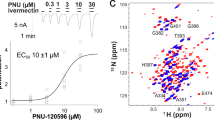Abstract
The structures of functional peptides corresponding to the predicted channel-lining M2 segments of the nicotinic acetylcholine receptor (AChR) and of a glutamate receptor of the NMDA subtype (NMDAR) were determined using solution NMR experiments on micelle samples, and solid-state NMR experiments on bilayer samples. Both M2 segments form straight transmembrane α-helices with no kinks. The AChR M2 peptide inserts in the lipid bilayer at an angle of 12° relative to the bilayer normal, with a rotation about the helix long axis such that the polar residues face the N-terminal side of the membrane, which is assigned to be intracellular. A model built from these solid-state NMR data, and assuming a symmetric pentameric arrangement of M2 helices, results in a funnel-like architecture for the channel, with the wide opening on the N-terminal intracellular side.
This is a preview of subscription content, access via your institution
Access options
Subscribe to this journal
Receive 12 print issues and online access
$189.00 per year
only $15.75 per issue
Buy this article
- Purchase on Springer Link
- Instant access to full article PDF
Prices may be subject to local taxes which are calculated during checkout





Similar content being viewed by others
References
Colquhoun, D. & Sakmann, B. From muscle endplate to brain synapses: a short history of synapses and agonist-activated ion channels. Neuron 20, 381–387 ( 1998).
Lena, C. & Changeux, J. P. Pathological mutations of nicotinic receptors and nicotine-based therapies for brain disorders. Curr. Opin. Neurobiol. 7, 674–682 (1997).
Hollmann, M. & Heinemann, S. Cloned glutamate receptors. Annu. Rev. Neurosci. 17, 31–108 (1994).
Unwin, N. Acetylcholine receptor channel imaged in the open state. Nature 373, 37–43 ( 1995).
Oiki, S., Madison, V. & Montal, M. Bundles of amphipathic transmembrane α-helices as a structural motif for ion-conducting channel proteins: studies on sodium channels and acetylcholine receptors. Proteins 8, 226–236 (1990).
Kuner, T., Wollmuth, L.P., Karlin, A., Seeburg, P.H. & Sakmann, B. Structure of the NMDA receptor channel M2 segment inferred from accessibility of substituted cysteines. Neuron 17, 343–352 ( 1996).
Hollmann, M., Maron, C. & Heinemann, S. N-glycosylation site tagging suggests a three transmembrane domain topology for the glutamate receptor GluR1. Neuron 13, 1331–1343 (1994).
Oblatt-Montal, M., Buhler, L.K., Iwamoto, T., Tomich, J.M. & Montal, M. Synthetic peptides and four-helix bundle proteins as model systems for the pore-forming structure of channel proteins. The transmembrane segment M2 of the nicotinic cholinergic receptor channel is a key pore lining structure. J. Biol. Chem. 268, 14601–14607 (1993).
Opella, S. J. NMR and membrane proteins. Nat. Struct. Biol., NMR Suppl. 4, 845–848 (1997).
Kay, L.E., Ikura, M., Tschudin, R. & Bax, A. Three-dimensional triple resonance NMR spectroscopy of isotopically enriched proteins. J. Magn. Reson. 89, 496–514 (1990).
Bax, A. & Ikura, M. An efficient 3D NMR technique for correlating the proton and 15N backbone amide resonance with the alpha-carbon of the preceding residue in uniformly 15N/13C enriched proteins. J. Biomol. NMR 1, 99–104 (1991).
Wuthrich, K. NMR of proteins and nucleic acids (Wiley-Interscience, New York; 1986).
Opella, S.J. & Stewart, P.L. Solid-state nuclear magnetic resonance structural studies of proteins. Methods Enzymol. 176 , 242–275 (1989);.
Ketchem, R.R., Hu, W. & Cross, T. A. High-resolution conformation of gramicidin A in a lipid bilayer by solid-state NMR. Science 261, 1457–1460 (1993).
Marassi, F. M. et al. Dilute spin-exchange assignment of solid-state NMR spectra of oriented proteins: acetylcholine M2 in bilayers. J. Biomol. NMR, in the press (1999).
Doyle D.A. et al. The structure of the potassium channel: molecular basis of K+ conduction and selectivity. Science 280, 69–77 (1998).
Akabas, M.H., Kaufmann, C., Archdeacon, P. & Karlin, A. Identification of acetylcholine receptor channel lining residues in the entire M2 segment of the alpha subunit. Neuron 13, 919–927 (1994).
Galzi, J.L. et al. Mutations in the channel domain of a neuronal nicotinic receptor convert ion selectivity from cationic to anionic. Nature 359, 500–505 (1992).
Charnet, P. et al. An open channel blocker interacts with adjacent turns of α-helices in the nicotinic acetylcholine receptor. Neuron 4, 87–95 (1990).
Gesell, J.J., Opella, S.J., Sun, W. & Montal, M. in Proc. 6th Symp. Protein Soc. p.52 (San Diego, CA, July 25–29, 1992; abstr. s33).
Iwamoto, T., Grove, A., Montal, M. O., Montal, M. & Tomich, J.M. Chemical synthesis and characterization of peptides and oligomeric proteins designed to form transmembrane ion channels. Int. J. Pept. Protein Res. 43, 597– 607 (1994).
Bax, A., Griffey, R.H. & Hawkins B.L. Correlation of proton and nitrogen-15 chemical shifts by multiple quantum NMR. J. Magn. Reson. 55, 301–315 (1983).
Piotto, M., Saudek, V. & Sklenar, V. Gradient-tailored excitation for single-quantum NMR spectroscopy of aqueous solutions. J. Biomol. NMR, 2, 661–665 (1992).
Clore, G.M., Nilges, M., Sukumaran, D., Brunger, A., Karplus, M. & Gronenborn, A. The three-dimensional spectra of α1-purothiamin in solution: combined use of nuclear magnetic resonance, distance geometry and restrained molecular dynamics. EMBO J. 5, 2729–2735 (1986).
Vuister, G.W. & Bax, A. Quantitative J correlation: a new approach for measuring homonuclear three-bond J(HNHα) coupling constants in 15N-enriched proteins. J. Am. Chem. Soc. 115 , 7772–7777 (1993).
Brunger, A.T. X-PLOR version 3.1. a system for X-ray crystallography and NMR (Yale University Press, New Haven, CT; 1992).
Pines, A., Gibby, M.G. & Waugh, J.S. Proton-enhanced NMR of dilute spins in solids. J. Chem. Phys. 59, 569–590 (1973).
Levitt, M.H., Suter, D. & Ernst, R.R. Spin dynamics and thermodynamics in solid-state NMR cross polarization. J. Chem. Phys. 84, 4243– 4255 (1986).
Wu, C.H., Ramamoorthy, A. & Opella, S.J. High resolution dipolar solid-state NMR spectroscopy. J. Magn. Reson. A 109, 270– 272 (1994).
Ramamoorthy, A., Wu, C.H. & Opella, S.J. Three-dimensional solid-state NMR experiment that correlates the chemical shift and dipolar coupling frequencies of two heteronuclei. J. Magn. Reson. B 107, 88–90 (1995).
Marassi, F.M., Ramamoorthy, A & Opella, S.J. Complete resolution of the solid-state NMR spectrum of a uniformly 15N labeled membrane protein in phospholipid bilayers. Proc. Natl. Acad. Sci. USA 94, 8551–8556 (1997).
Brenneman, M.T. & Cross, T.A. A method for the analytic determination of polypeptide structure using solid-state nuclear magnetic resonance: the metric method. J. Chem. Phys., 92, 1483–1494 (1990).
Wu, C.H., Ramamoorthy, A., Gierasch, L.M. & Opella, S.J. Simultaneous characterization of the amide 1H chemical shift, 1H-15N dipolar coupling, and 15N chemical shift interaction tensors in a peptide bond by three-dimensional solid-state NMR spectroscopy. J. Am. Chem. Soc. 117, 6148–6149 (1995).
Tycko, R., Stewart, P.L. & Opella, S.J. Peptide plane orientations determined by fundamental and overtone 14N NMR. J. Am. Chem. Soc. 108, 5419–5425 (1986).
Laskowski, R.A., Macarthur, M.W., Moss, D.S. & Thornton, J.M. PROCHECK—a program to check the stereochemical quality of protein structures. J. Appl. Crystallogr. 26, 283– 291 (1993).
Oblatt-Montal, M., Yamazaki, M., Nelson, R. & Montal, M. Formation of ion channels in lipid bilayers by a peptide with the predicted transmembrane sequence of botulin neurotoxin A. Protein Sci. 4, 1490–1497 (1995).
Smart, O.S., Goodfellow, J.M. & Wallace, B.A. The pore dimensions of gramicidin A. Biophys. J. 65, 2455–2460 ( 1993).
Kraulis, P. MOLSCRIPT: a program to produce both detailed and schematic plots of protein structures. J. Appl. Crystallogr. 24, 946 –950 (1991).
Acknowledgements
We thank R. Nelson for assistance with molecular modeling and the preparation of Fig. 5. We thank W. Sun and A. Ferrer-Montiel for their participation in the initial experiments. This research was supported by grants from the National Institute of General Medical Sciences to S.J.O and to M.M. This research utilized the Resource for Solid-State NMR of Proteins at the University of Pennsylvania, supported by a grant from the Biomedical Research Technology Program, National Center for Research Resources, National Institutes of Health. F.M.M. was supported by postdoctoral fellowships from the Natural Sciences and Engineering Research Council of Canada and the Medical Research Council of Canada. A.P.V. was supported by a postdoctoral fellowship from FAPESP-Brazil (Fundacao de Amparo a Pesquisa do Estado de Sao Paulo).
Author information
Authors and Affiliations
Rights and permissions
About this article
Cite this article
Opella, S., Marassi, F., Gesell, J. et al. Structures of the M2 channel-lining segments from nicotinic acetylcholine and NMDA receptors by NMR spectroscopy. Nat Struct Mol Biol 6, 374–379 (1999). https://doi.org/10.1038/7610
Received:
Accepted:
Issue Date:
DOI: https://doi.org/10.1038/7610
This article is cited by
-
Uniaxial Diffusional Narrowing of NMR Lineshapes for Membrane Proteins Reconstituted in Magnetically Aligned Bicelles and Macrodiscs
Applied Magnetic Resonance (2018)
-
Sensitivity enhancement for membrane proteins reconstituted in parallel and perpendicular oriented bicelles obtained by using repetitive cross-polarization and membrane-incorporated free radicals
Journal of Biomolecular NMR (2017)
-
Resonance assignments of a membrane protein in phospholipid bilayers by combining multiple strategies of oriented sample solid-state NMR
Journal of Biomolecular NMR (2014)
-
Lipid bilayer preparations of membrane proteins for oriented and magic-angle spinning solid-state NMR samples
Nature Protocols (2013)
-
A de novo peptide hexamer with a mutable channel
Nature Chemical Biology (2011)



